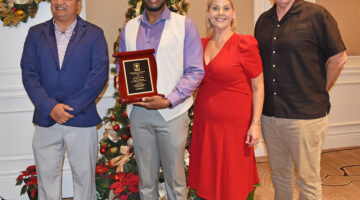Sunscreen ban passes first step
BY PRU SOWERS
KONK LIFE STAFF WRITER
Bucking presentations on alternative science, warnings of a surge in skin cancer and a hint of a lawsuit, Key West City Commissioners voted preliminarily to implement a ban on sunscreen products containing two ingredients thought to damage coral reefs.
The proposed ordinance passed unanimously on first reading at the Jan. 15 city commission meeting and needs a second, final vote to become law. However, at least three commissioners said they still had reservations about the proposed ban on sunscreens containing oxybenzone and octinoxate, two ingredients found in most sunscreen products. If not satisfied, commissioners Greg Davila, Clayton Lopez and Sam Kaufman indicated they might vote against the measure on the final vote, which could take place at the Feb. 5 meeting if not postponed.
Kaufman and Mayor Teri Johnston asked for more research on the proposed ordinance before the second vote, hoping for clearer, unbiased information on whether oxybenzone and octinoxate are dangers to the health of the coral reefs off Key West. Those reefs, part of the third largest barrier reef in the world, stretching from West Palm Beach to the Dry Tortugas, are a critical part of the tourist industry that supports Key West.
Over 50 scientists, residents, charter boat captains and sunscreen industry advocates on both sides of the ban spoke at the Jan. 15 commission meeting. While the majority of speakers supported the ordinance, several representatives from the sunscreen manufacturing industry also attended. Dr. Carys Mitchelmore, a professor at the University of Maryland’s center for environmental science and speaking on behalf of the Personal Care Products Council, a trade association representing the cosmetics and personal care industry, gave a 10-minute presentation refuting previous studies showing damaging water toxicity levels caused by oxybenzone and octinoxate. While there is no question the world’s coral reefs are under stress, the cause of bleaching and other diseases keeping coral from reproducing has not been solidly determined, Mitchelmore said, adding that warming ocean temperatures are likely a cause.
“This is very much an emerging field of scientific study,” she said. “Overall, there has to be [more study] to be able to complete an environmental risk assessment.”
Mitchelmore was refuting a presentation made to commissioners two weeks ago by Dr. Craig Downs from the Haereticus Environmental Laboratory, which was instrumental in providing research that convinced Hawaiian officials to ban sun care products containing oxybenzone and octinoxate starting in 2021. Downs presented data from his water studies, which show the two ingredients can contaminate coral, fish, bird eggs and sea turtle eggs. He pointed to a water test at Ft. Zachary Taylor State Park on March 18, 2017, that showed water just off the beach contained 8,114 parts per trillion of oxybenzone. A 2015 study published in the journal Archives of Environmental Contamination and Toxicology found oxybenzone had a toxic effect on marine life starting at a concentration of 62 parts per trillion.
But several dermatologists spoke about the danger of skin cancer, arguing that oxybenzone and octinoxate help make sunscreen products easier to apply and are effective against UVA, the ultraviolet rays that cause skin cancer. Local dermatologist Dr. Darel Pruett said he had seen an increase in skin cancer among his patients.
“I hate oxybenzone but it works,” he said.
“Your incidence of melanoma in Monroe County are twice as high as statewide averages,” warned Karen Ross, vice president of the Personal Care Products Council. Ross also hinted at a potential lawsuit if the proposed ban is approved, saying her organization’s attorneys had submitted a legal opinion to city officials that the ban would constitute “pre-emption,” which prohibits a local government from banning a business or industry that is otherwise allowed to operate under state and/or federal law.
But two separate manufacturers of mineral-based sunscreen spoke at the meeting, saying there are plenty of alternative products that do not contain oxybenzone and octinoxate and are just as effective at protecting against UVA rays. And Commissioner Jimmy Weekley pointed out that skin cancer rates have risen dramatically over the past several years even with the prevalence of sunscreen products containing the two disputed ingredients.
“Somebody’s got to wake up and see there are alternatives,” he said. “This is something we need to do in this community to protect our economy… This is our time to do something for our generation.”
Commissioner Davila disagreed, however, pointing out that his research turned up hundreds of non-sunscreen skin and cosmetics products that contain oxybenzone and octinoxate. The proposed ordinance would ban all of those products, as well, he said. Davila referred to a 2018 Consumer Reports ranking of sunscreen products. No mineral-based products made the top 13 list.
“My concern is if we pass this, we will definitely be limiting the access of our residents to the best sunscreens available,” he said. “I have a really hard time telling a mom or dad that they can’t buy the best sunscreen available.” Davila proposed a restricted ban limited to charter boats taking snorkeling, diving and fishing customers out to the reefs.
Commissioner Lopez said that Davila had “reawakened” his questions about how much impact the two disputed ingredients have on coral reefs.
“What if we’re blaming the wrong guy,” Lopez asked.
[livemarket market_name="KONK Life LiveMarket" limit=3 category=“” show_signup=0 show_more=0]




No Comment